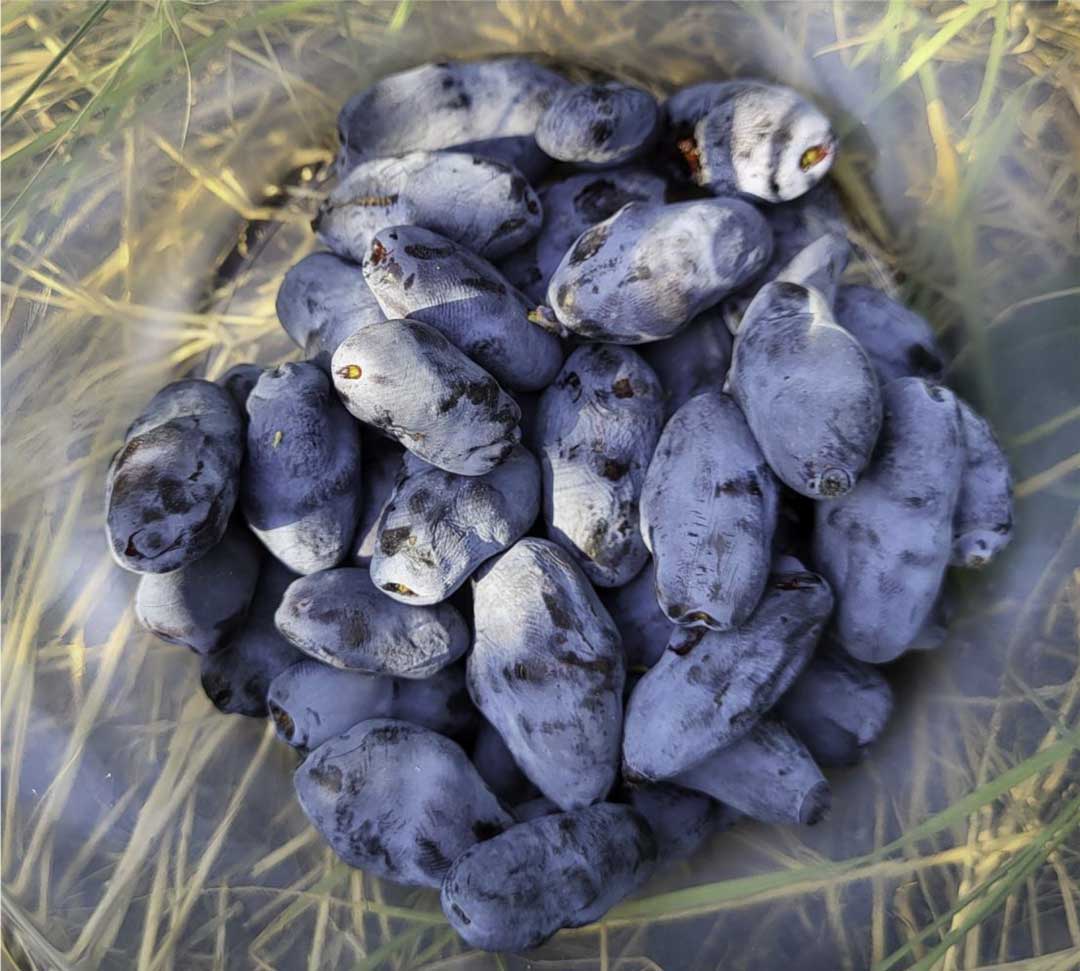
'Boreal Bliss'
Boreal Bliss will be available in late 2025 or 2026.
By Bob BorsHistory
In 2011, we intercrossed 16 selections from Maxine Thompson’s program with pollen from wild plants that Bob Bors gathered across Canada. The wild Canadian pollen used was bulked according to the province from which it came. While we know that the female parent was Maxine’s #46.55, we only know that the male parent was from somewhere in Nova Scotia. Seeds from those crosses were germinated and field planted in 2012. Since 2018 we have been taking field notes on this set of plants. By 2019, 14-02-44.8 (breeding number of ‘Boreal Bliss’) was recognized as a superior selection and began to be used as a parent for breeding purposes the next growing season 2020. For the last 4 years, ‘Boreal Bliss’ has been recognized as the most consistently productive Japanese-Canadian hybrid with great taste. ‘Boreal Bliss’ is the first haskap cultivar to be released that has wild Canadian haskap in its lineage. Plant Breeder’s Rights are Pending #24-11810.
Noteworthy is that we’ve used dozens of Maxine’s selections in breeding but 46.55 consistently has the best offspring. 46.55 is also the mother of ‘Aurora’, ‘Boreal Blizzard’ and ‘Boreal Beast’.
Characteristics
Flavour: ‘Boreal Bliss’ was so named because we feel it is a breakthrough in flavour. In 2023, visiting experienced growers and retired technician Rick Sawatzky were highly impressed with its flavour and remarked that it was somewhat different than other cultivars. I recognized the ‘new’ flavour as largely being derived from its wild Canadian parent. Panelists gave it ratings between 4 and 4.5 (out of 5) which is similar to ratings that ‘Boreal Beast’ got 5 years ago, but with different people on the panel. Flavourdeveloped nicely about a week after the berries turned blue.
Bloom and ripening: In Saskatoon, ‘Boreal Bliss’s bloom and ripening was closely in sync with ‘Boreal Beast’ and both are in the mid/late category. Bloom was in the 3rd week of May and ripening was the 3rd week of July. It crossed best with both ‘Boreal Beast’ and ‘Boreal Blizzard’ when test crosses were done. (Note; it was not tested against ‘Aurora’ because Aurora blooms earlier).
Growth Habit is upright and somewhat spreading, like Aurora and Boreal Beast.
Potential advantages
Companion to Boreal Beast Research done in Quebec on other haskap varieties showed that yields can be higher if companion plants for pollination are placed in the same row. This is because honeybees tend to stay in the same row when gathering pollen and nectar. Most growers, that mechanically harvest, prefer to have only one variety per row, but will place companion plants in the next row over. They don’t interplant varieties in the same row because different varieties may not ripen at the same time or it might look strange to have different looking berries from each variety. Both ‘Boreal Bliss’ and ‘Boreal Beast’ seem to be in sync for blooming and ripening. This observation is based on the original bushes located in the same field but about 8 rows apart. The berries of these two are similar size and have similar slightly wavy skin, although berry shape is slightly different. Both are slightly flattened with a thinner section near the stem and wider in the middle of the berries. But ‘Boreal Bliss’ has a point near the flower end, looking somewhat like an arrowhead, while ‘Boreal Beast’ has a more rounded end looking more like a flattened pear. I don’t think the average consumer would notice the difference. Both are excellent for flavour although the flavours are different. Perhaps a blended fruit product made with these two varieties will have more depth. Both varieties held onto their fruit for at least 2 weeks after optimum ripeness. Both are mid-late ripening and can extend the harvest season. Southern or maritime adaptation The female parent was from Maxine Thompson’s program. Maxine used Haskap from Hokkaido Japan which is one of the warmest places where this species can be found in Asia. Then Maxine intercrossed and selected haskap in Oregon which is even warmer than Hokkaido. The male parent was from Nova Scotia which is one of the warmest places in Canada where haskap can be found in the wild. Since both parents are from southern areas, perhaps there will be some synergy for southern or for maritime adaptation
'Boreal Bliss' Details
Breeder denomination: 14-02-44.8
Lineage: 50% Japanese, 50% Wild Canadian from Nova Scotia.
Bloom Time Category: Mid to late, It is most in sync with ‘Boreal Beast’.
Harvest Season: ripens after Saskatoon berries and just before dwarf sour cherries, which is late July in Saskatoon.
Fruit Weight: 1.95g (2023).
Fruit Shape: Spear or arrowhead shaped.
Fruit Firmness: Excellent, has crunch.
Flavour: Excellent, very nice aroma and aftertaste that is a bit different from other cultivars. Some would say a bit superior flavor.
Brix: 21.5 (2023) Total Acidity: 1.22 malic acid equivalent (2023).
Bush Habit: Upright, some spreading.
Bush Vigour: Strong.
Mildew Resistance: Excellent.
Productivity: Very good.
Acknowledgements
For five years, early Haskap breeding and research was funded by plant sales, workshop fees and volunteer labour. Since 2007, Saskatchewan Agriculture’s Agriculture Development Fund (ADF) gave us 4 grants in a row that allowed a 10 fold increase in haskap research. By 2011, royalties paid by growers and collected by our propagators allowed a doubling of research efforts by funding haskap breeding in general and graduate students stipends and their research. 65% of royalties go directly to the Fruit program. 35% of royalties go to a general horticulture fund that buys and maintains equipment and facilities

